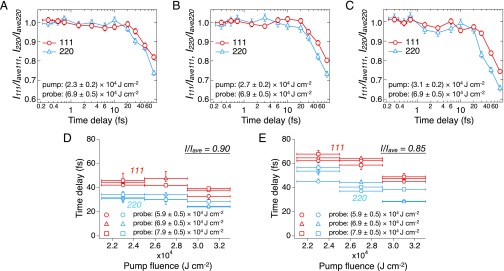Fig. 3.
Temporal changes of the probe diffraction intensities of the diamond 111- and 220 reflections after irradiation of the pump pulse. (A–C) Dependence of the probe diffraction intensities of the 111- and 220 reflections on the time delay at specific fluences of the pump [(A) (2.3 ± 0.2) 104 J cm−2, (B) (2.7 ± 0.2) 104 J cm−2, and (C) (3.1 ± 0.2) 104 J cm−2] and the probe [(6.9 ± 0.5) 104 J cm−2)] pulses. (D and E) Time delays for (red) and (blue) decreasing to be, respectively, 90% and 85% of and for different fluence conditions of the pump [(2.3 ± 0.2) 104 J cm−2, (2.7 ± 0.2) 104 J cm−2, and (3.1 ± 0.2) 104 J cm−2] and the probe [(5.9 ± 0.5) 104 J cm−2, (6.9 ± 0.5) 104 J cm−2, and (7.9 ± 0.5) 104 J cm−2] pulses. After evaluating and for the respective conditions, we performed the linear interpolation of and between the measured conditions of time delays and determined the values of the time delays shown in D and E.

